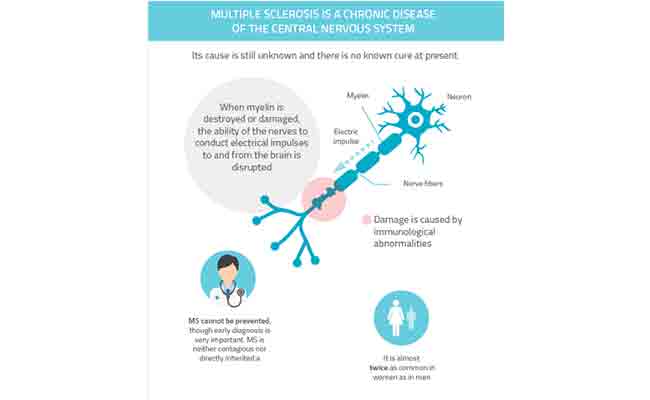Neither the cause nor the cure of multiple sclerosis are known at present. Multiple sclerosis (MS) is a chronic autoimmune and neurodegenerative disease that affects the central nervous system (brain and spinal cord). On World Multiple Sclerosis Day, celebrated this year on May 31st, we would like to give voice to the 2.5 million people worldwide who suffer from this disease.
What is multiple sclerosis?
Multiple sclerosis is a disease of the central nervous system that affects the brain and spinal cord. The body’s immune system attacks the myelin—a substance that wraps around nerve fibers—which results in poor electrical communication between neurons, causing numerous symptoms which we will describe below.
Who gets multiple sclerosis?
Multiple sclerosis is a disease of young adults because it is most commonly diagnosed between ages 20 and 40. MS is the leading cause of non-traumatic neurological disability and the second most common cause of disability in young adults, after traffic accidents. MS is also a disease that strikes more women than men.
How is multiple sclerosis diagnosed?
MS is neither contagious nor directly inherited and cannot be prevented. Early diagnosis is very important.
The diagnosis of multiple sclerosis is typically based on:
- Medical history
- Neurological examination
- Evoked potentials
- Cerebrospinal fluid analysis
- Demyelinating lesions that can be identified by magnetic resonance imaging. Magnetic resonance imaging (MRI) is one of the most-used tools for MS diagnosis. It is a non-invasive medical technique that captures detailed images of the brain and the spinal cord.
With the use of magnetic resonance, lesions in the brain caused by attacks on the myelin from the immune system can be seen. It is also necessary to clarify that this test cannot be regarded as conclusive because all lesions do not register on MRI scans and because there are conditions other than MS that can produce identical abnormalities.
What are the symptoms of multiple sclerosis?
Symptoms of multiple sclerosis depend on the specific areas affected and differ from one person to another. Symptoms also vary even in the same person depending on the stage of the disease.
The most common symptoms are:
- Fatigue
- Vision problems: blurred vision; double vision; optic neuritis; involuntary rapid eye movement; etc.
- Problems with movement, balance and coordination: mobility and walking issues, loss of balance, tremors, ataxia, dizziness and vertigo, clumsiness of a limb, lack of coordination, muscle weakness in arms or legs.
- Spasticity: involuntary muscle spasms and stiffness.
- Sensory problems: tingling, numbness, burning sensation, muscle pain, sensitivity to heat, etc.
- Speech problems: slower speech, slurring of words, scanning speech.
- Bladder and bowel problems: frequency and/or urgency of urination, constipation, etc.
- Sexual problems: erectile dysfunction, decreased sexual desire, altered genital sensations.
- Cognitive and emotional problems: cognitive impairments in memory, encoding and retrieval of information, and emotional problems such as anxiety and depression.
Treatment
Currently there is no cure for multiple sclerosis, but there are drugs that slow the progression of the disease and ease its symptoms.
These drugs must be administered in combination with sessions of physiotherapy, occupational therapy, and speech therapy. In addition, the neuropsychologist is fundamental for addressing cognitive deficits that develop in the disease course.
If you found this article informative, you might be interested in learning about the differences between multiple sclerosis (MS) and amyotrophic lateral sclerosis (ALS); click here.
